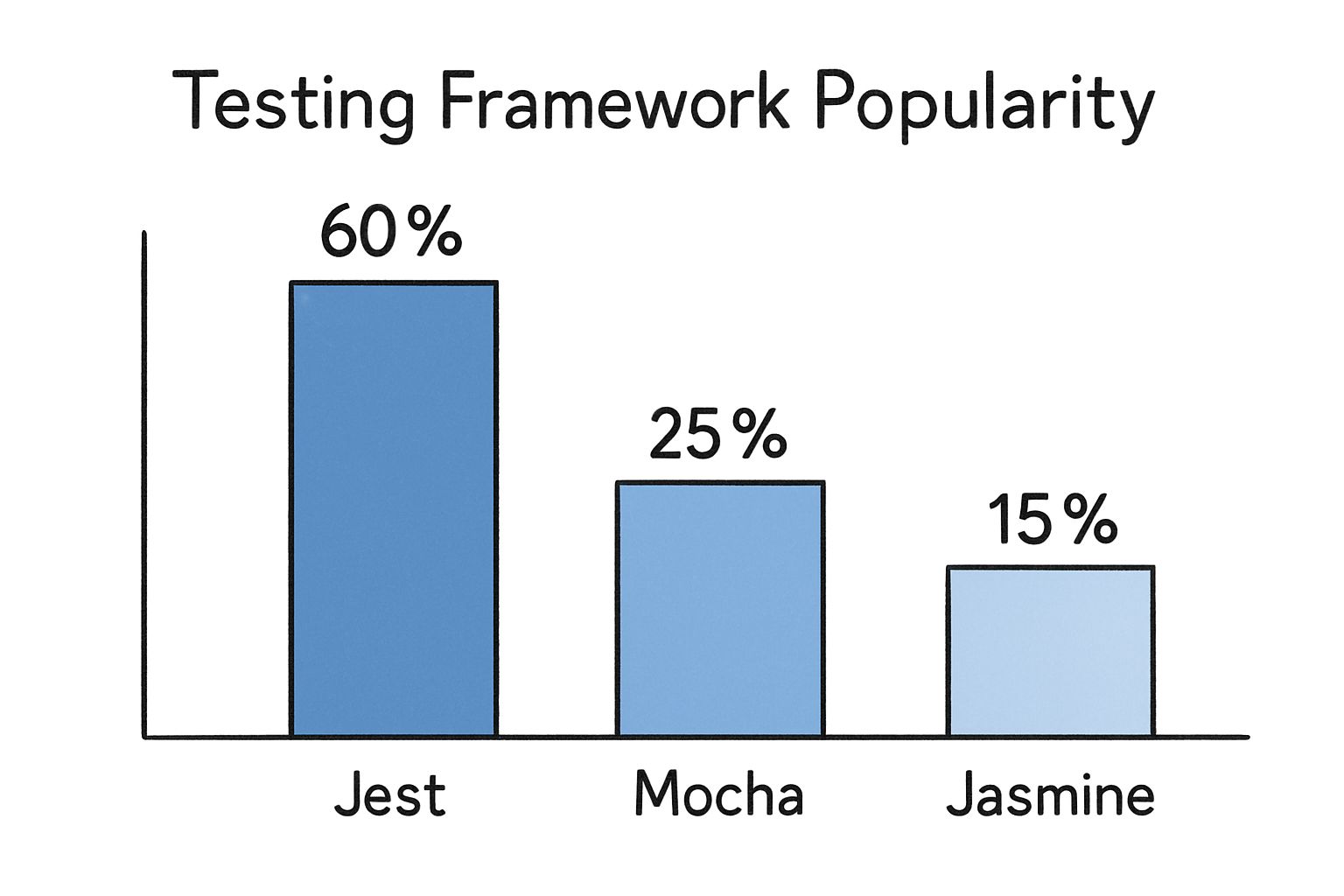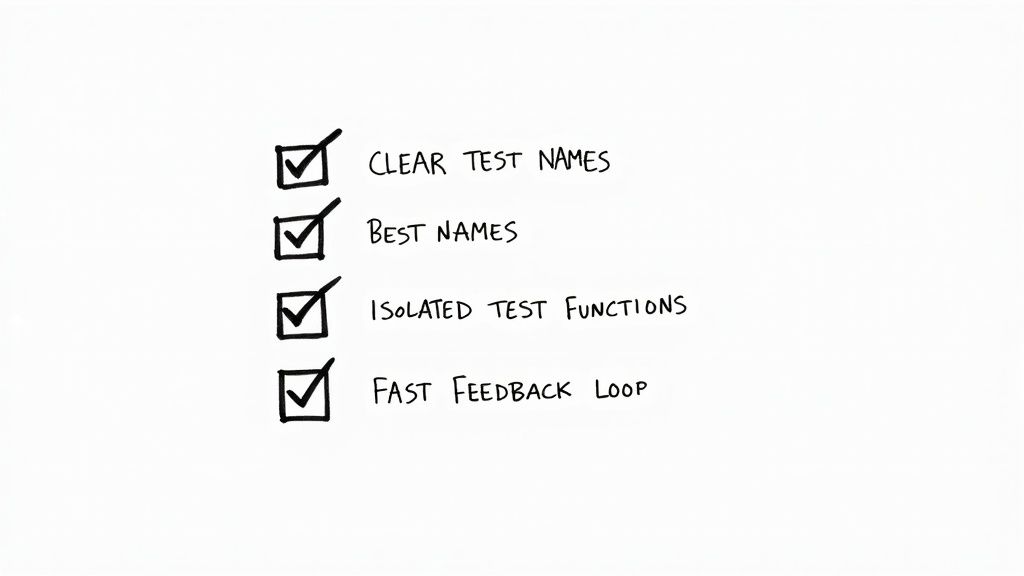Master JavaScript Unit Tests: Your Complete Testing Roadmap

Why JavaScript Unit Tests Actually Matter Now
I remember when writing tests felt like extra credit—something you did only if you had time left at the end of a sprint. It was always the first thing to get cut when a deadline was breathing down your neck. But the JavaScript world has changed, and what was once a "nice-to-have" is now a fundamental part of being a professional developer.
From Afterthought to Foundation
The biggest change is how we think about testing. It's no longer a final, grudging step but an integral part of the building process. This isn't just about following "best practices"; it's about building developer confidence. With a solid suite of JavaScript unit tests, you can add new features or refactor old ones without the fear of unknowingly breaking something else.
That nagging anxiety—"what else will this change affect?"—is replaced by the assurance that your tests are watching your back. This safety net transforms development from a stressful, high-wire act into a more controlled, creative flow.
It's Not Just a Niche Practice Anymore
This isn't just a feeling; the numbers show a massive cultural shift. The adoption of JavaScript unit testing has exploded. As of 2025, the combined monthly downloads for popular frameworks like Jest, Mocha, and Jasmine are over a staggering 1.5 billion. This is a global standard, not a fringe activity.
A 2023 survey of more than 20,000 developers revealed that over 75% now use automated unit testing in their projects. This surge isn't accidental; it's a direct response to the growing complexity of web applications and the need for more reliable code. You can explore more data on testing framework adoption to see the trend for yourself.
The Hidden Benefits of Writing Tests
While catching bugs early is the most obvious benefit, the true value of JavaScript unit tests runs much deeper. They fundamentally improve the way you write code.
- It Forces Better Code Design: Let's be honest, you can't easily test a giant, tangled function. The act of writing a test forces you to think in smaller, more focused, and decoupled modules. Your code becomes more organized and maintainable almost by accident.
- It Acts as Living Documentation: A well-named test file, like
calculate-shipping-cost.test.js, tells a clear story. Each test case, such asit('should apply free shipping for orders over $50'), describes a specific requirement. This becomes perfect, always-up-to-date documentation on how your code is supposed to work. - It Makes Refactoring Safe: This is a huge one. Ever wanted to improve the performance of a critical piece of logic but were too afraid to touch it? With a good test suite, you can rewrite it completely. As long as all the tests pass, you have a high degree of confidence that you haven't altered its essential behavior.
- It Creates a Faster Feedback Loop: Finding a bug with a unit test takes seconds. Finding that same bug after it's been deployed to staging—or worse, production—can mean hours of stressful debugging, log diving, and frantic hotfixes.
Ultimately, writing JavaScript unit tests isn't about slowing yourself down. It's about building a foundation of quality that allows you to move faster and with much more confidence in the long run.
Choosing Your Testing Framework Without The Overwhelm
Diving into JavaScript unit tests often starts with a tough decision: picking your toolset. With so many options available, it's easy to feel stuck before you even write your first test. Each framework makes a compelling case, but the goal isn't to find the most popular tool—it's to find the right one for your team and your project's unique demands.
Let's cut through the marketing noise and get straight to what really matters.
It's More Than a Popularity Contest
While a framework's community size is a good indicator of support and longevity, it shouldn't be your only deciding factor. The three names you'll hear most often are Jest, Mocha, and Jasmine. Each one is built on a different philosophy, which can have a big impact on your day-to-day workflow.
To get a clear picture of where things stand, take a look at the developer landscape.

The data speaks for itself: Jest has a commanding lead. This isn't just a trend; it's a reflection of a wider developer preference for integrated testing tools. The adoption rate for Jest has climbed past 65%, making it the clear favorite for projects big and small. Its all-in-one design, which includes mocking and snapshot testing with zero initial setup, makes it incredibly appealing. Meanwhile, respected alternatives like Mocha and Jasmine have seen their growth level off. You can see how Jest continues to dominate the testing space here.
To help you see the differences at a glance, here's a quick comparison of the top contenders. Think of this as your cheat sheet for understanding the core philosophies of each framework.
JavaScript Testing Framework Comparison
A comprehensive comparison of popular JavaScript testing frameworks including setup complexity, features, performance, and ideal use cases
| Framework | Setup Difficulty | Built-in Features | Best For | Community Support |
|---|---|---|---|---|
| Jest | Easy | All-in-one (runner, assertions, mocking, coverage) | React projects, teams wanting a quick setup, all-in-one solutions. | Very Large & Active |
| Mocha | Moderate | Test runner only (bring your own assertion/mocking libraries) | Teams that value flexibility, custom toolchains, Node.js backends. | Large & Established |
| Jasmine | Easy | All-in-one (runner, assertions, some mocking) | Angular projects (via Protractor), teams wanting a classic BDD syntax. | Solid & Mature |
As you can see, the choice often boils down to whether you prefer an all-in-one solution like Jest or a more modular, customizable setup like Mocha.
The "All-in-One" vs. "Build Your Own" Philosophies
The fundamental difference between these tools really comes down to two distinct approaches to building a testing environment.
- Jest: The All-in-One Powerhouse The main draw for Jest is its "batteries-included" nature. When you install it, you get a complete package: a test runner, an assertion library (
expect), powerful mocking capabilities, and code coverage reports. This simplicity is a huge advantage for teams that want to get running immediately without spending time configuring and debating different packages. - Mocha: The Flexible and Modular Choice Mocha takes the opposite approach. It provides the core test running functionality and leaves the rest up to you. You're expected to bring your own tools for assertions, like Chai, and for mocking, like Sinon.js. This modular design offers amazing flexibility, letting you build a testing stack that is perfectly suited to your team's preferences. Developers who want explicit control over their tools often prefer Mocha's unopinionated style.
Making the Right Choice for Your Team
So, how do you decide? Instead of getting lost in feature lists, ask your team a few practical questions:
- How quickly do we need to get started? If you need to write tests today with minimal fuss, Jest is almost always the best choice. Its zero-configuration setup is hard to beat.
- Does our team prefer flexibility over convention? If your engineers enjoy picking and choosing their tools and have strong opinions on assertion styles, Mocha’s modular approach will feel empowering.
- Are we working in a React ecosystem? Jest was created by Facebook and its integration with React projects is seamless, making it the default and most natural option.
Choosing a testing framework is about finding the right balance between setup speed, long-term control, and your team's culture. It’s a decision that shapes your development workflow, so picking the tool that aligns with how your team works is the real key to success.
Setting Up Your Testing Environment The Right Way
Getting your testing environment right from the start isn't about chasing perfection; it's about being practical. A good setup makes writing JavaScript unit tests feel like a seamless part of your coding routine, whereas a clunky one creates drag and slows everyone down. The goal is to build a foundation that grows with your project, not against it.
Structuring for Success
One of the first decisions you'll face is where to stash your test files. Some developers prefer a single, top-level /tests folder, but from my experience, colocating tests with their source files is a game-changer. This means your Button.jsx component and its Button.test.js test file live together in the same directory.
This approach offers two huge advantages:
- Discoverability: You never have to go searching for a test; it’s right there. This simple proximity encourages developers to actually update tests when they change the source code.
- Context: It makes code reviews much clearer. When a pull request modifies a component, the changes to its tests are right there in the same view.
These initial structural decisions are crucial. If you want to explore the higher-level thinking behind these choices, this guide on creating a test environment strategy is an excellent resource.
Essential Configuration and Tooling
With your file structure sorted, the next step is getting your test runner configured. For most projects using a modern framework like Jest, this is refreshingly straightforward. All you typically need is a simple script in your package.json file to get things running.
"scripts": { "test": "jest" }
Frameworks like Jest are built to be approachable, which helps lower the barrier for teams just getting into testing. Their own documentation often highlights this ease of use.

The tagline “delightful JavaScript Testing” and its emphasis on zero-configuration setups are major reasons for its widespread adoption. It lets you write tests instead of wrestling with your tools. While a jest.config.js file is always there for deeper customization on more complex projects, the default setup is more than capable for most situations.
As you finalize your environment, think about building good habits that extend beyond just executing tests. Consider automation, naming conventions, and security. Here are a few tips:
- Consistent Naming: Always stick to a consistent suffix, like
.test.jsor.spec.js. This makes your test files easy to identify and allows test runners to discover them automatically. - CI/CD Integration: Make sure your
npm testcommand is ready to be dropped right into your continuous integration pipeline. Automating your tests is the best way to catch regressions before they cause real problems. - Secure Your Setup: As you automate scripts and manage dependencies, it's a great time to think about the bigger picture. Maintaining good cybersecurity practices helps protect your codebase from vulnerabilities. This proactive approach ensures your testing practices contribute to the overall health and security of your project.
Writing Tests That Actually Catch Problems
With your testing environment ready, it’s time to tackle the real work: writing JavaScript unit tests that are actually useful. It’s surprisingly easy to write tests just to make a coverage report look good. But a test suite full of shallow checks is worse than having no tests at all—it creates a dangerous false sense of security. The real objective is to build a safety net that catches problems before they ever affect your users.
Why 100% Coverage Is a Trap
Chasing a 100% code coverage score often feels like a productive goal, but it's a classic vanity metric. You can easily hit every line of code in a function without ever verifying its logic. This is why you need a mindset shift from coverage to confidence. The most important question your tests should answer is: "Am I confident that our app's core features work correctly?"
So, where do you begin? I always start by identifying the most critical parts of the codebase. Think about the functions that handle essential business logic, complex math, or something as sensitive as user authentication. A single, well-written test on a crucial payment processing function is far more valuable than ten tests on a simple component that just displays static text. Focusing your effort this way guarantees you're protecting what matters most.
Structuring Tests for Clarity and Maintenance
A great test tells a story. The most effective unit tests follow a simple but powerful narrative: set up the initial conditions, perform a single action, and then check the result. This is widely known as the Arrange-Act-Assert pattern, and it’s my go-to model for keeping tests clean and easy to understand.
Let's say you have a function called applyCoupon that applies a discount to a shopping cart. A good test using this pattern would look like this:
- Arrange: First, you create the necessary objects, like a sample shopping cart and a valid coupon code.
- Act: Next, you call the
applyCouponfunction with the cart and coupon you just created. - Assert: Finally, you confirm the outcome. Did the cart's total price decrease by the correct amount?
This structure makes the test's purpose immediately obvious. Your test descriptions should be just as clear. Instead of a vague name like "coupon test," opt for something descriptive like it('should apply a 15% discount for a valid FALL15 coupon'). This simple practice turns your test suite into living documentation for your application. This approach is a cornerstone of many unit testing best practices because it makes your intentions crystal clear.
Beyond the Happy Path: Testing for Edge Cases
The tests that provide the most value are the ones that explore the messy, real-world edge cases. What happens if an API call returns null? Or if a user enters a negative number into a quantity field? These are the tests that stop surprising bugs from making it to production. Most code doesn't operate in a perfect bubble; it interacts with databases, external services, and unpredictable user input.
For example, your app might process financial data from an external accounting platform. The goal here isn't to test the external service—it's to test your code's reaction to the data it receives, whether it's a success or an error. Managing the infrastructure that provides this data is a whole other topic. For instance, setting up reliable environments for platforms like QuickBooks requires careful planning, as detailed in guides on Cloud Hosting for QuickBooks: Your Complete Setup Guide. Probing these real-world scenarios is what builds true, lasting confidence in your codebase.
Mastering Mocks And Test Isolation Like A Pro

The term "unit test" suggests testing something in complete isolation, but let's be real—our code rarely lives on a deserted island. A function you write might need to call an API, query a database, or rely on another module to get its job done. This is where test doubles, a family of stand-in objects, become one of your most valuable tools for writing focused and reliable JavaScript unit tests.
The Art of Faking It: Mocks, Stubs, and Spies
You’ll often hear these terms thrown around interchangeably, but each one plays a distinct role in your testing toolkit. Thankfully, modern frameworks like Jest make creating them incredibly simple.
- Stubs: These are the simplest fakes. A stub's only job is to return a predefined value when called. For instance, you could stub a
user.isLoggedIn()method to always returntrue. This lets you test a component's logged-in state without needing a real user session. - Spies: A spy is like an undercover agent for your code. It wraps a real function and quietly observes it, recording details like how many times it was called and what arguments were passed. Spies are perfect for verifying that one part of your code correctly triggers another without interfering with the original function's behavior.
- Mocks: Mocks are the most assertive type of fake. They come pre-programmed with expectations about how they should be used. If a mock isn't called exactly as you specified—or isn't called at all—the test will fail. They are great for enforcing strict interactions between modules.
When to Mock and When to Hold Back
There's a simple golden rule that will guide most of your decisions here: mock what you don't own. You should always create fakes for dependencies that are outside of your direct control.
Here are the prime candidates for mocking:
- External APIs: Your unit tests should never make real network requests. Doing so makes them slow, unreliable, and dependent on a network connection. Mock the API client to return predictable success or error responses, so you can test how your code handles both scenarios.
- Databases: Connecting to a real database during a unit test is a recipe for slow and flaky tests. Your tests need to be fast and self-contained. Mocking the data layer to provide sample data is the way to go.
- System Functions: Functions like
Date.now()or anything that touches the file system can make your tests unpredictable. By mocking these, you ensure your tests are deterministic—they produce the same outcome every single time they run, whether it's today or a year from now.
However, be careful about going too far with your own internal modules. Over-mocking can create a dangerous blind spot where your tests pass even when the application is broken. A test that mocks every single internal dependency only proves that your code can talk to fakes, not that it works with its real collaborators.
This delicate balance is at the heart of practices like Test-Driven Development, which you can explore further in this guide for developers on Test-Driven Development. The goal is to isolate the unit under test, not every function it calls. True confidence comes from knowing your code works with its immediate neighbors, and learning to strike this balance is what builds a truly trustworthy test suite.
Solving The Problems Everyone Faces But Nobody Talks About

Getting your mocks to behave is a big win, but it’s not the final boss. The real challenge comes from maintaining a large test suite. The official documentation for your framework won't prepare you for the gut-wrenching feeling of a test that fails randomly or a suite that takes longer to run than your coffee break.
These are the kinds of problems that make even seasoned developers wonder if JavaScript unit tests are worth the trouble. Let's dig into these common frustrations and solve them for good.
Taming the Flaky Test Monster
A flaky test is the ultimate productivity killer. It passes on your local machine, fails in the CI/CD pipeline, and then, just to mock you, passes again when you rerun the job. This kind of inconsistency destroys trust in your entire testing process. Fortunately, the culprits are usually easy to spot once you know where to look.
- Asynchronous Operations: This is the most frequent cause. Your test assertion runs before an async operation, like a
setTimeoutor a promise, has a chance to finish. The fix is to consistently useasync/awaitin your tests and ensure your test runner is configured to wait for promises to resolve completely. - State Leakage: Every test should run in a perfectly clean sandbox. If one test alters a global object, a mock, or a database entry and doesn't clean up after itself, it can poison the environment for the next test. Use
beforeEachandafterEachhooks to meticulously set up and tear down the state for every single test. - Time-Dependency: Any test that relies on
Date.now()is a ticking time bomb waiting to explode at the most inconvenient moment. By mocking the system clock, you can provide a stable, predictable time for every test run, eliminating this variable entirely.
Keeping Your Test Suite Fast and Lean
As your application grows, a slow test suite can become a serious bottleneck, discouraging developers from running tests as often as they should. This isn't just a minor annoyance; it’s a major drag on team productivity. In fact, some studies show that nearly 40% of developers find writing effective tests difficult, with slow and flaky tests being their biggest complaints.
In large codebases with over 10,000 unit tests, it’s not unusual for a full test run to take an hour, bringing development to a standstill. You can dive into more developer survey data on testing challenges to see you're not alone.
The secret to speed is a disciplined approach to mocking. Be aggressive about mocking any dependency that involves I/O, like network requests or file system access. Save your comprehensive end-to-end tests for a separate, dedicated CI job, and focus on keeping your unit test suite as fast as possible.
To help you diagnose and fix these issues, here’s a quick-reference table that covers the most common problems you'll likely face.
Common Testing Problems and Solutions
A practical guide to identifying and solving the most frequent JavaScript unit testing challenges developers encounter.
| Problem | Symptoms | Root Cause | Solution | Prevention |
|---|---|---|---|---|
| Flaky Tests | Tests pass locally but fail randomly in CI. A re-run often fixes the issue. | Asynchronous race conditions, state shared between tests, or dependency on real-time clocks. | Use async/await properly. Implement strict setup/teardown in beforeEach/afterEach. Mock the system clock. |
Enforce a "no shared state" policy in code reviews. Use linters to catch unhandled promises. |
| Slow Test Suite | The feedback loop is too long. Developers avoid running the full suite locally. | Tests are performing real I/O (network, database, file system). Mixing unit and integration tests. | Aggressively mock all external dependencies. Separate test types into different CI jobs or scripts. | Regularly profile the test suite to identify slow tests. Establish clear guidelines on what to mock. |
| Brittle Test Data | A small change to a data model requires updating dozens of test files. | Test data is hardcoded as large, static JSON or objects directly within tests. | Use factory functions to generate test data programmatically. | Make factory functions a standard part of your testing setup from the project's start. |
This table acts as a great diagnostic tool. When you see a symptom, you can quickly identify the likely cause and apply a proven solution, saving you hours of frustrating debugging.
Managing Test Data Without the Headache
Maintaining huge, hardcoded JSON objects as test data is a classic maintenance trap. The moment your data model changes, you’re stuck hunting down and updating dozens of fragile test fixtures. The professional way to handle this is by using factory functions.
A factory is just a simple helper function that builds a data object for you. Instead of a static user object, you create a createUser() function that returns a valid user.
const defaultUser = createUser(); const adminUser = createUser({ role: 'admin', hasVerifiedEmail: true });
This approach gives you two massive advantages. First, your tests become much cleaner and more readable because they only need to specify the data that is directly relevant to the test case. Second, when the user model inevitably changes—for instance, you add a lastLoginAt field—you only have to update the createUser factory in one place. This small change in approach makes your test suite far more resilient and easier to maintain as your application scales.
Creating A Testing Culture That Actually Sticks
Knowing how to write JavaScript unit tests is one thing, but getting your team to write good ones consistently is a different challenge altogether. The real work isn't just in the code; it's in building a culture where quality isn't just another box to check. We’ve all been on projects where testing felt like a punishment or where flaky tests were a constant source of frustration. To make testing stick, you have to make it the easiest and most logical choice, turning it into a safety net the whole team trusts.
Make Quality a Shared Responsibility
Your code review process is the perfect place to start. Instead of having pull request reviews focus only on the implementation details, make the tests a primary part of the conversation. This simple shift turns quality assurance into a genuine team sport.
Encourage reviewers to ask questions that go beyond "does it work?":
- Does this test actually explain why this change was made?
- Are there any tricky edge cases we're forgetting?
- If a new developer sees this test fail a year from now, will they know what broke?
When you do this, code reviews stop being about gatekeeping and start being about mentoring. It's a chance for the team to collectively level up their testing skills and build a shared sense of ownership over the application's stability.
Lower the Barrier to Entry
If writing a test is more complicated than writing the actual feature, you have a problem. Testing needs to be the path of least resistance, especially for new folks joining the team. When it's confusing, people will find reasons to skip it. The goal is to make adding a solid test feel almost automatic.
Here are a few practical ways my teams have done this:
- Start with solid boilerplates. Create simple template files for common test scenarios, like a component test or a utility function test. This gets rid of the "blank page" fear and gives everyone a starting point.
- Agree on simple conventions. A consistent file structure and naming pattern (like
MyComponent.jsxand its correspondingMyComponent.test.jsx) removes guesswork and mental overhead. - Automate the feedback loop. Your test suite should run automatically with every single commit. A developer should find out they broke a test instantly, not hours or days later.
Redefine Success Beyond Coverage
Please, stop chasing the 100% code coverage dragon. It's a vanity metric that often encourages bad habits, like writing useless tests just to make a number go up. It absolutely does not guarantee a quality application.
Instead, focus on what actually matters: developer confidence and application stability. True success isn't a percentage; it's the feeling your team gets when they can refactor a critical piece of code without holding their breath. It’s seeing bug reports for tested features practically disappear. When a test snags a regression before it gets anywhere near production, celebrate it! Post it in your team's chat. That's how you reinforce the real value of the work.
This cultural foundation, built on shared responsibility and smart automation, is what separates struggling teams from high-performing ones. Enforcing these standards automatically is the key. Mergify’s Merge Queue ensures every change is tested against the latest code, making quality a non-negotiable part of your workflow and preventing broken builds. Discover how Mergify can automate your quality gates.





